Related Research Articles

Zacatecas is the principal city within the municipality in Mexico of the same name, and the capital and the largest city of the state of Zacatecas. Located in north-central Mexico, the city had its start as a Spanish mining camp in the mid-16th century. Native Americans had already known about the area's rich deposits of silver and other minerals. Due to the wealth that the mines provided, Zacatecas quickly became one of the most important mining cities in New Spain. The area saw battles during the turbulent 19th century, but the next major event was the Battle of Zacatecas during the Mexican Revolution when Francisco Villa captured the town, an event still celebrated every anniversary. Today, the colonial part of the city is a World Heritage Site, due to the Baroque and other structures built during its mining days. Mining still remains an important industry. The name Zacatecas is derived from the Zacateco people and has its roots in Nahuatl. The name means "people of the grasslands".
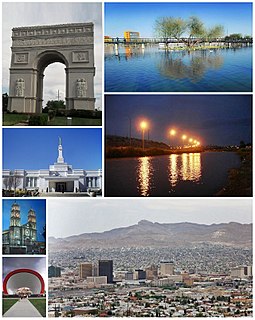
Ciudad Juárez is the most populous city in the Mexican state of Chihuahua. It is commonly referred to as Juárez and was known as El Paso del Norte until 1888. Juárez is the seat of the Juárez Municipality with an estimated population of 1.5 million people. It lies on the Rio Grande river, south of El Paso, Texas, United States. Together with the surrounding areas, the cities form El Paso–Juárez, the second largest binational metropolitan area on the Mexico–U.S. border, with a combined population of over 2.7 million people.
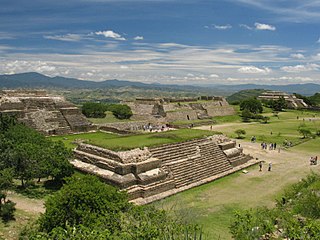
Oaxaca de Juárez, also Oaxaca City or simply Oaxaca, is the capital and largest city of the eponymous Mexican state Oaxaca. It is the municipal seat for the surrounding Municipality of Oaxaca. It is in the Centro District in the Central Valleys region of the state, in the foothills of the Sierra Madre at the base of the Cerro del Fortín, extending to the banks of the Atoyac River. Heritage tourism makes up an important part of the city's economy, and it has numerous colonial-era structures as well as significant archeological sites and elements of the continuing native Zapotec and Mixtec cultures. The city, together with the nearby archeological site of Monte Albán, was designated in 1987 as a UNESCO World Heritage Site. It is the site of the month-long cultural festival called the "Guelaguetza", which features Oaxacan dance from the seven regions, music, and a beauty pageant for indigenous women.

Morelia is a city and municipal seat of the municipality of Morelia in the north-central part of the state of Michoacán in central Mexico. The city is in the Guayangareo Valley and is the capital and largest city of the state. The main pre-Hispanic cultures here were the Purépecha and the Matlatzinca, but no major cities were founded in the valley during this time. The Spanish took control of the area in the 1520s. The Spanish under Viceroy Antonio de Mendoza founded a settlement here in 1541 with the name of Valladolid, which became rival to the nearby city of Pátzcuaro for dominance in Michoacán. In 1580, this rivalry ended in Valladolid's favor and it became the capital of the viceregal province. After the Mexican War of Independence, the city was renamed Morelia in honor of José María Morelos, who hailed from the city. In 1991, the city was declared a UNESCO World Heritage Site for its well-preserved historical buildings and layout of the historic center. It is tradition to name people born on September 30th after the city. The city population in 2020 was 743,275 inhabitants. The municipality had 849,053 inhabitants, and the Metropolitan Area, composed by Morelia, Tarímbaro, and Charo municipalities had 988,704 inhabitants, according to the XIV Census.

The city of Chihuahua(La Ciudad de Chihuahua) is the state capital of the Mexican state of Chihuahua. As of 2020, the city of Chihuahua had a population of 925,762 inhabitants. while the metropolitan area had a population of 988,065 inhabitants.

Cuernavaca is the capital and largest city of the state of Morelos in Mexico. The city is located around a 90-minute drive south of Mexico City using the Federal Highway 95D.
Ricardo Legorreta Vilchis was a Mexican architect. He was a prolific designer of private houses, public buildings and master plans in Mexico, the United States of America and some other countries.

San Ángel is a colonia or neighborhood of Mexico City, located in the southwest in Álvaro Obregón borough. Historically, it was a rural community, called Tenanitla in the pre-Hispanic period. Its current name is derived from the El Carmen monastery school called San Ángel Mártir. San Ángel remained a rural community, centered on the monastery until the 19th and 20th centuries, when the monastery was closed and when the area joined urban sprawl of Mexico City. However, the area still contains many of its former historic buildings and El Carmen is one of the most visited museums in the city. It is also home to an annual flower fair called the Feria de las Flores, held since 1856.

Colonia Roma, also called La Roma or simply, Roma, is a district located in the Cuauhtémoc borough of Mexico City just west of the city's historic center, and in fact is no longer a single colonia (neighbourhood) but now two officially defined ones, Roma Norte and Roma Sur, divided by Coahuila street.
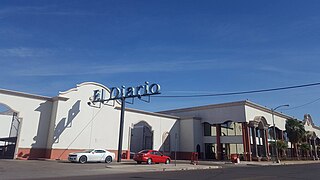
The El Diario de El Paso is the primary Spanish-language newspaper for the U.S. city of El Paso, Texas. The paper was founded on May 16, 2005 by El Diario de Juárez. It originally started out as a Mexican newspaper circulated throughout Ciudad Juárez under the name Diario de Juárez. In 1982 Diario de Juárez entered into the El Paso business community by opening a small sales and circulation office. The company became incorporated in Texas as Editora Paso del Norte, Inc..

Casa Chihuahua Centro de Patrimonio Cultural, once known as the Federal Palace of Chihuahua, is an early 20th-century building in the city centre of Chihuahua, Chih., Mexico. It served as the federal building for the city until 2004, when it was renovated as a city museum, specialising in travelling exhibits. It also houses, in the basement, the jail cell of father Miguel Hidalgo y Costilla, considered the Father of the Nation. Father Hidalgo was the first leader of the insurgency for independence from Spain. He was captured by the Spaniards early in 1811, tried and executed on 30 July 1811 at the neighbouring Government Palace. His jail cell is a national shrine.

Ciudad Colonial is the historic central neighborhood of the Dominican Republic's capital Santo Domingo. It is the oldest continuously inhabited European-established settlement in the Americas. The area has been declared a World Heritage Site by UNESCO. It is also known as Zona Colonial or more colloquially as "La Zona".

The historic center of Mexico City, also known as the Centro or Centro Histórico, is the central neighborhood in Mexico City, Mexico, focused on Zócalo or main plaza and extending in all directions for a number of blocks, with its farthest extent being west to the Alameda Central. The Zocalo is the largest plaza in Latin America. It can hold up to nearly 100,000 people.
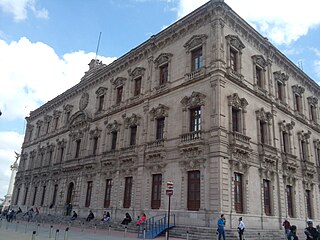
The Government Palace of Chihuahua is a 19th-century building in the city of Chihuahua, Mexico. Located in the heart of the city, it is of special interest since it houses the executive offices of the governor of the state of Chihuahua and, until 2004, the state legislature met here. The building is a landmark in the city as it contains a shrine commemorating the execution of Miguel Hidalgo, considered the Father of the Country, who died at the hands of a Spanish firing squad on July 30, 1811. The Altar de la Patria, or Altar of the Fatherland is located at the exact spot where Miguel Hidalgo died.

Toluca[toˈluka], officially Toluca de Lerdo[toˈluka ðe ˈleɾðo], is the state capital of the State of Mexico as well as the seat of the Municipality of Toluca. With a population of 910,608 as of the 2020 census, Toluca is the fifth most populous city in Mexico. The city forms the core of the Greater Toluca metropolitan area, which with a combined population of 2,347,692 forms the fifth most populous metropolitan area in the country.

The Museo de la Lealtad Republicana, also known as the Museo Casa Juárez, is a 19th-century building in the city centre of Chihuahua, Mexico. It housed the constitutional government of President Benito Juárez during his stay in Chihuahua while Maximilian of Habsburg reigned as Emperor of Mexico, supported by the French, and was thus the de facto National Palace of Mexico.

Many of Mexico's older architectural structures, including entire sections of Pre-Hispanic and colonial cities, have been designated World Heritage sites for their historical and artistic significance. The country has the largest number of sites declared World Heritage Sites by UNESCO in the Americas.
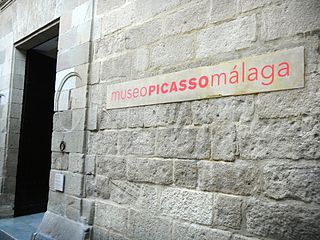
The Museo Picasso Málaga is a museum in Málaga, Andalusia, Spain, the city where artist Pablo Ruiz Picasso was born. It opened in 2003 in the Buenavista Palace, and has 285 works donated by members of Picasso's family. In 2009, the Fundación Paul, Christine y Bernard Ruiz-Picasso that owned the collection merged with the Fundación Museo Picasso Málaga that operated the museum, which is based in the home on Málaga's Plaza de la Merced that was Picasso's birthplace, and is now the Museo Casa Natal. The new merged foundation is the "Fundación Museo Picasso Málaga. Legado Paul, Christine y Bernard Ruiz-Picasso".

The Museum of Fine Arts of Álava is located in Vitoria-Gasteiz, the capital of the Basque Country. Since its opening in 1942, it has undergone many transformations. The museum is dedicated to Spanish art from the 18th to the 20th century and to the Basque art from the period 1850-1950.